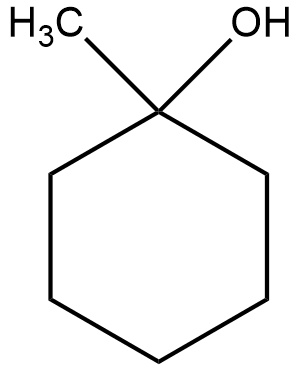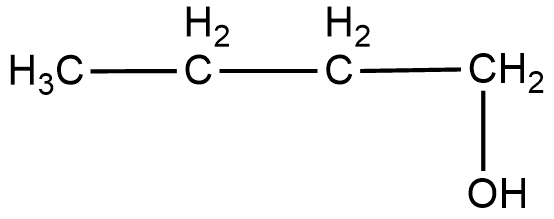
Answer
370.8k+ views
Hint: The acid catalyzed dehydration reaction implies the removal of a water molecule from the compound in the form of hydroxyl ion and hydrogen ion from the adjacent carbon. Hence, for the given compounds, the alcohol group will be removed with a hydrogen ion from an adjacent carbon. If two products are possible, then the major product will be the one that is more substituted.
Complete step by step answer:
Let us consider the first compound
(i) The structural formula of the compound $1-methyl\;cyclohexanol$ can be shown as

Now, the acid catalyzed dehydration can be shown as

Now, the charge of electron deficiency is on a tertiary carbon. Hence, it is already stable.
Now, to remove the deficiency, the carbon will form a double bond with one of its adjacent carbon, which loses hydrogen ion to form the double bond. As here the electron deficient carbon has three adjacent carbons, three products will be formed as shown below

The second and third products are just a mirror image of each other. Hence, they will be considered as one product.
Now, according to Saytzeff Rule, the alkene having more number of carbon groups attached to the double bonded carbon is obtained in more proportion. From the above figure, we can understand that the second product has more carbon groups attached to the double bond carbon. Hence, the second product is the major product. Thus, the overall reaction can be expressed as

(ii) The structural formula of the compound $Butan-1-ol$ can be shown as

Now, the acid catalyzed dehydration can be shown as

Now, the electron deficient carbon is primary. Hence, the positive charge will move to the adjacent secondary carbon as it is more stable.

Now, to remove the deficiency, the carbon will form a double bond with one of its adjacent carbon, which loses hydrogen ion to form the double bond. As here the electron deficient carbon has two adjacent carbons, two products will be formed as shown below

Now, according to Saytzeff Rule, the alkene having more number of carbon groups attached to the double bonded carbon is obtained in more proportion. From the above figure, we can understand that the first product has more carbon groups attached to the double bond carbon. Hence, the first product is the major product. Thus, the overall reaction can be expressed as

Note:
Here, for removing water molecules, we should always first remove the hydroxyl ion and show the electron deficient carbon. If the electron deficient carbon is primary, the positive charge will shift to a secondary carbon to make the deficiency stable. If a tertiary carbon is present, the positive charge will be the most stable there, due to the positive inductive effect of carbon groups. Finally the electron deficient carbon makes a double bond if the adjacent carbon. If a choice is available, the double bond is always formed with the more substituted carbon.
Complete step by step answer:
Let us consider the first compound
(i) The structural formula of the compound $1-methyl\;cyclohexanol$ can be shown as

Now, the acid catalyzed dehydration can be shown as

Now, the charge of electron deficiency is on a tertiary carbon. Hence, it is already stable.
Now, to remove the deficiency, the carbon will form a double bond with one of its adjacent carbon, which loses hydrogen ion to form the double bond. As here the electron deficient carbon has three adjacent carbons, three products will be formed as shown below

The second and third products are just a mirror image of each other. Hence, they will be considered as one product.
Now, according to Saytzeff Rule, the alkene having more number of carbon groups attached to the double bonded carbon is obtained in more proportion. From the above figure, we can understand that the second product has more carbon groups attached to the double bond carbon. Hence, the second product is the major product. Thus, the overall reaction can be expressed as

(ii) The structural formula of the compound $Butan-1-ol$ can be shown as

Now, the acid catalyzed dehydration can be shown as

Now, the electron deficient carbon is primary. Hence, the positive charge will move to the adjacent secondary carbon as it is more stable.

Now, to remove the deficiency, the carbon will form a double bond with one of its adjacent carbon, which loses hydrogen ion to form the double bond. As here the electron deficient carbon has two adjacent carbons, two products will be formed as shown below

Now, according to Saytzeff Rule, the alkene having more number of carbon groups attached to the double bonded carbon is obtained in more proportion. From the above figure, we can understand that the first product has more carbon groups attached to the double bond carbon. Hence, the first product is the major product. Thus, the overall reaction can be expressed as

Note:
Here, for removing water molecules, we should always first remove the hydroxyl ion and show the electron deficient carbon. If the electron deficient carbon is primary, the positive charge will shift to a secondary carbon to make the deficiency stable. If a tertiary carbon is present, the positive charge will be the most stable there, due to the positive inductive effect of carbon groups. Finally the electron deficient carbon makes a double bond if the adjacent carbon. If a choice is available, the double bond is always formed with the more substituted carbon.
Recently Updated Pages
Who among the following was the religious guru of class 7 social science CBSE

what is the correct chronological order of the following class 10 social science CBSE

Which of the following was not the actual cause for class 10 social science CBSE

Which of the following statements is not correct A class 10 social science CBSE

Which of the following leaders was not present in the class 10 social science CBSE

Garampani Sanctuary is located at A Diphu Assam B Gangtok class 10 social science CBSE

Trending doubts
A rainbow has circular shape because A The earth is class 11 physics CBSE

Which are the Top 10 Largest Countries of the World?

Fill the blanks with the suitable prepositions 1 The class 9 english CBSE

How do you graph the function fx 4x class 9 maths CBSE

What is BLO What is the full form of BLO class 8 social science CBSE

The Equation xxx + 2 is Satisfied when x is Equal to Class 10 Maths

Give 10 examples for herbs , shrubs , climbers , creepers

Difference between Prokaryotic cell and Eukaryotic class 11 biology CBSE

Change the following sentences into negative and interrogative class 10 english CBSE




